Blog Blog Day 1 – June 25, 2018 Blog Day 2 – June 26, 2018 Blog Day 3 – June 27, 2018 Blog Day 4 – June 28, 2018 Blog Day 5 – June 29, 2018 Blog Day 6 – June 30, 2018 Blog Day 7 – July 1, 2018 Blog Day 8 – July 2, Read More ...

ICRPS 2018 Summer Institute | Tuskegee, AL | June 24-July 07
"Social Justice, Rural and Natural Resource Policy"
George Washington Carver Museum
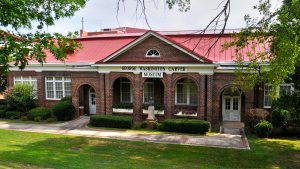 Bearing the name of one of the most influential scientists of all time, and certainly the most recognizable African-American agricultural researcher in history, the George Washington Carver Museum consists of many exhibits, interpretive programs, a book sales area and two introductory films on George Washington Carver and Booker T. Washington. The museum was developed with substantial support from admirer and industrialist Henry Ford. Carver wanted the fruits of his life’s work on display at the museum as he hoped that the exhibits would inspire children to live better lives. Carver first served as Director of the Agricultural Department where he developed agricultural extension services for black farmers and homemakers. Milbank Hall was the site of his agricultural experiments. His last laboratory was housed in the Carver Museum.
Bearing the name of one of the most influential scientists of all time, and certainly the most recognizable African-American agricultural researcher in history, the George Washington Carver Museum consists of many exhibits, interpretive programs, a book sales area and two introductory films on George Washington Carver and Booker T. Washington. The museum was developed with substantial support from admirer and industrialist Henry Ford. Carver wanted the fruits of his life’s work on display at the museum as he hoped that the exhibits would inspire children to live better lives. Carver first served as Director of the Agricultural Department where he developed agricultural extension services for black farmers and homemakers. Milbank Hall was the site of his agricultural experiments. His last laboratory was housed in the Carver Museum.
The Oaks at Tuskegee
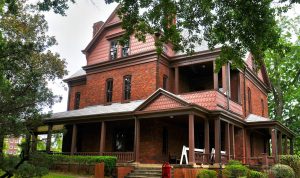 The Oaks was the home of the founder of Tuskegee Institute, now Tuskegee University. As a tangible evidence of his success, it was also a place of employment and an on-the-job training site for students. In addition, it was also a place where educators, businessmen, and farmers were received and entertained. The Oaks, “a large comfortable home,” was built for Washington and his family. They moved into the house in 1900. Washington lived there until his death in 1915. His widow, Margaret, lived at The Oaks until her death in 1925. Most furnishings were made by local craftsmen and students, and were acquired between 1885-1889. The Queen Anne style red brick house, with steam heating and electricity, was the first of its kind in Macon County. The Washingtons visited Europe the year construction began. The friezes in the parlor and library depict highlights of their trip. The house had a parlor, library, dining room, den, kitchen, family and guest rooms, breakfast room, five bathrooms, and veranda. The Oaks sat on three acres of gardens, orchards, and pastures.
The Oaks was the home of the founder of Tuskegee Institute, now Tuskegee University. As a tangible evidence of his success, it was also a place of employment and an on-the-job training site for students. In addition, it was also a place where educators, businessmen, and farmers were received and entertained. The Oaks, “a large comfortable home,” was built for Washington and his family. They moved into the house in 1900. Washington lived there until his death in 1915. His widow, Margaret, lived at The Oaks until her death in 1925. Most furnishings were made by local craftsmen and students, and were acquired between 1885-1889. The Queen Anne style red brick house, with steam heating and electricity, was the first of its kind in Macon County. The Washingtons visited Europe the year construction began. The friezes in the parlor and library depict highlights of their trip. The house had a parlor, library, dining room, den, kitchen, family and guest rooms, breakfast room, five bathrooms, and veranda. The Oaks sat on three acres of gardens, orchards, and pastures.
Tuskegee’s 25th anniversary in 1906 brought prominent people to The Oaks, including Secretary of War William Howard Taft, Harvard president Charles W. Eliot, and philanthropist Andrew Carnegie. The Oaks housed a reception for President Theodore Roosevelt and another for the wedding of Washington’s daughter, Portia..

Tuskegee University Archives Repository
The University Archives includes material documenting the history and growth of Tuskegee University. Books (including faculty publications), manuscripts, Tuskegee University periodicals and newspapers, ephemera, photographic images, disc and tape recordings, and other archival items are available for research under supervised conditions
Grey Columns
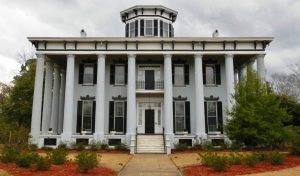
Grey Columns was built in 1857 and has a uniquely interesting history. when a Union general was given orders to burn Tuskegee to the ground, one of the officers found out that his frat brother at Yale, Ed Varner (whose family owned Grey Columns), was at the home tending to wounds he had received. It was because of this connection that the town was spared. Today, Grey Columns is home to the President of Tuskegee University.
Moton Field
Located to the north of the central business district of Tuskegee, Moton Field was the only primary flight facility for African-American pilot candidates in the U.S. Army Air Corps (Army Air forces) during World War II. It was named for Robert Russa Moton, second president of Tuskegee Institute. Moton Field was built between 1940-1942, with funding from the Julius Rosenwald Fund, to provide primary flight training under a contract with the U.S. military.
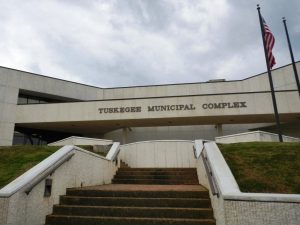
The Tuskegee Municipal Complex
The City of Tuskegee Municipal Complex houses the offices of many city officials including the Mayor and City Council Member. It also hosts the Utilities Board of Tuskegee, and is occasionally the site of Town Hall meetings, which are open to the public.
 Tuskegee University Walmart Initiative
Tuskegee University Walmart Initiative
Tuskegee University is providing the leadership in Alabama and four other southeastern states including Arkansas, Texas, Georgia and Mississippi in developing market opportunities for socially and historically disadvantaged farmers. The overall project goal is to bridge the gaps between the ability of the target farmers to grow vegetable and fruit crops and their ability to package and market their crops in a manner that results in enhanced profitability and sustainability of their farming operations and quality of life.
Al Hooks Vegetable Production and Processing Center
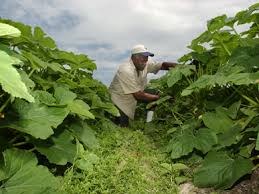 The Alphonso Hooks Family, located in Shorter, Alabama, has worked, owned, and operated their family farm of 200 acres for nearly fifty-one years. The property has been in the family for more than sixty years. His major crops are corn, watermelons, greens, strawberries, sweet potatoes, squash, peas, and okra. This diversified farm also has beef cattle, meat goats, poultry and catfish. He utilizes plasticluture technology in his crop production system and has a willingness to try new or improved techniques and research based information.
The Alphonso Hooks Family, located in Shorter, Alabama, has worked, owned, and operated their family farm of 200 acres for nearly fifty-one years. The property has been in the family for more than sixty years. His major crops are corn, watermelons, greens, strawberries, sweet potatoes, squash, peas, and okra. This diversified farm also has beef cattle, meat goats, poultry and catfish. He utilizes plasticluture technology in his crop production system and has a willingness to try new or improved techniques and research based information.
The Edmund Pettus Bridge

The Edmund Pettus Bridge stands as a symbol of the momentous changes taking place in Alabama, America, and the world. It was here that voting rights marchers were violently confronted by law enforcement personnel on March 7, 1965. The day became known as Bloody Sunday.
The march resumed on Sunday March 21, with court protection through Federal District Court Judge Frank M. Johnson, Jr., who weighed the right of mobility against the right to march and ruled in favor of the demonstrators. “The law is clear that the right to petition one’s government for the redress of grievances may be exercised in large groups…,” said Judge Johnson, “and these rights may be exercised by marching, even along public highways.”
This time, 3,200, versus the initial 600, marches headed east out of Selma, across the Edmund Pettus Bridge and on to Montgomery. Marches walked 12 miles a day and slept in fields. By the time they reached the capitol on Thursday, March 25, they were 25,000-strong. Less than five months later, President Lyndon Johnson signed the Voting Rights Act of 1965 — the best possible redress of grievances.
The George Washington Carver Agricultural Experiment Station
The search for new knowledge at Tuskegee University began very soon after its inception. In the early 1890’s, Booker T. Washington, with the help of local and state governments, put together a plan to make research at Tuskegee University a reality. The result of the plan was legislation passed by the Alabama State Legislature on February 15, 1897, to establish the Tuskegee State Experiment Station on the campus. George Washington Carver became the first director of the Tuskegee Experiment Station. He held this position from 1897 until 1943. During his tenure, his work in chemistry and applied research established for him, and for Tuskegee University,
international fame and recognition as a major contribution to the growth and development of the nation. Agricultural research continues to be a major endeavor at Tuskegee University. It has been greatly expanded in both programs and in personnel. Since the time of Carver, Tuskegee University has received significant financial support annually for research from the United States Government by way of Public Laws 89-106 (1972-1977) and 95 113 (1978-present), administered nationally by the Cooperative State Research Service of the U.S. Department of Agriculture. In addition to the search for new knowledge, significant benefits of the experiment station and its programs include support for scientists, training of students at the graduate level, and opportunities for exposure of undergraduate students to invaluable learning experiences which would not be available otherwise.
Prairie Farms Resettlement Community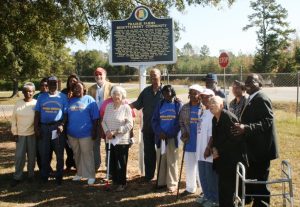
Beginning in the mid-1930s during the Great Depression, the federal New Deal promoted Land Resettlement to move farmers across the nation off worn out soil to new farmland. The Resettlement Administration, and its successor the Farm Security Administration, established one of these experimental planned communities here in west Macon County, the all-African American “Prairie Farms.” With more than 3,100 acres from two plantations purchased by the federal government, the resettlement plan included 34 farms, a community pasture, a community center and school, a store, and a home-site for the project manager. The Prairie Farms Resettlement Project included four local families and thirty families from the Tuskegee Planned Land Use Demonstration in east Macon County. Each farmstead had a new house with electricity, a drilled well and sanitary privy, a barn, stable, poultry house, vegetable house, and pig pen. Project manager Coleman Camp directed the diversified agricultural program based on livestock, especially hogs, vegetables, and hay and away from dependence on cotton.
The resettlement farmers organized the Prairie Farms Cooperative Association in June of 1937 and operated a store, canning plant, feed and grist mill, hay baler, tractor and plows, mowing machine, and cane mill. It provided farmers a way to buy equipment and supplies, market crops andlivestock, and gin cotton cooperatively. The association managed the community pasture and cattle herd. The Tuskegee Institute Prairie Farms Laboratory School, headed by Principal Deborah Cannon (Wolfe), provided education for the surrounding community. The school, supported by Tuskegee Institute faculty and students, consisted of a five-room building for grades 1-9, along with home economics facilities, a farm shop withtools, a health center equipped for examinations and treatment, a teachers’ cottage, a barn, and a playground. The school doubled as a community center and a site for evening adult education and vocational classes. From 1944-1951, the U.S. Government sold all of the farm units to private owners.
Additional Prairie Farms information, can tag my article in the Encyclopaedia of Alabama.